1994 CADILLAC SEVILLE sensor
[x] Cancel search: sensorPage 50 of 399
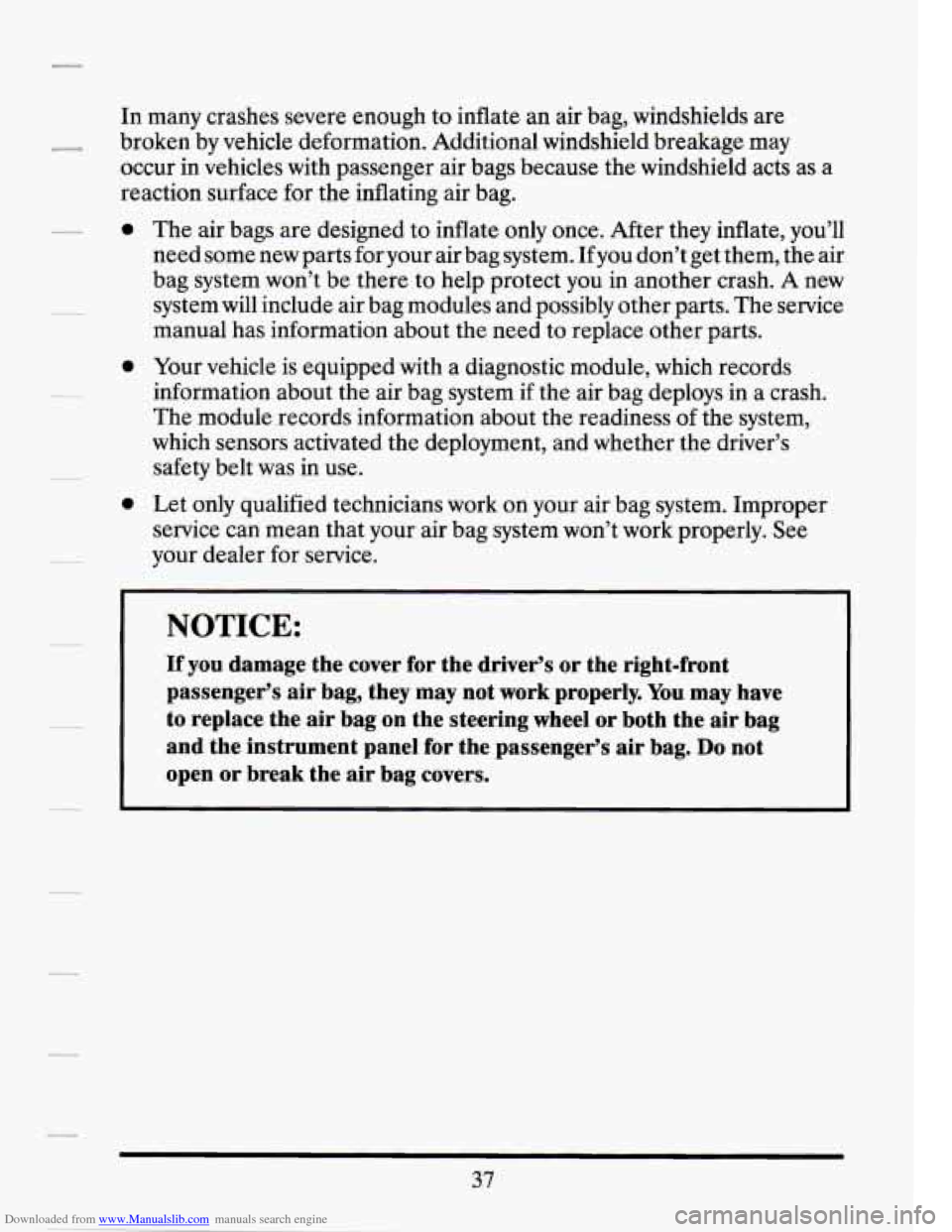
Downloaded from www.Manualslib.com manuals search engine In many crashes severe enough to inflate an air bag, windshields are
broken by vehicle deformation. Additional windshield breakage may
occur in vehicles with passenger air bags because the windshield acts as a
reaction surface for the inflating air bag.
0
0
0
The air bags are designed to inflate only once. After they inflate, you’ll
need some new parts for your air bag system. If you don’t get them, the air
bag system won’t be there to help protect you in another crash.
A new
system will include air bag modules and possibly other parts. The service
manual has information about the need to replace other parts.
Your vehicle is equipped with a diagnostic module, which records
information about the air bag system if the air bag deploys in a crash.
The module records information about the readiness
of the system,
which sensors activated the deployment, and whether the driver’s
safety belt was in use.
Let only qualified technicians work on your air bag system. Improper
service can mean that your air bag system won’t work properly. See
your dealer for service.
NOTICE:
If you damage the cover for the driver’s or the right-front
passenger’s air bag, they may not work properly.
You may have
to replace the air bag on the steering wheel or both the air bag
and the instrument panel for the passenger‘s air bag.
Do not
open or break the air bag covers.
37
Page 104 of 399
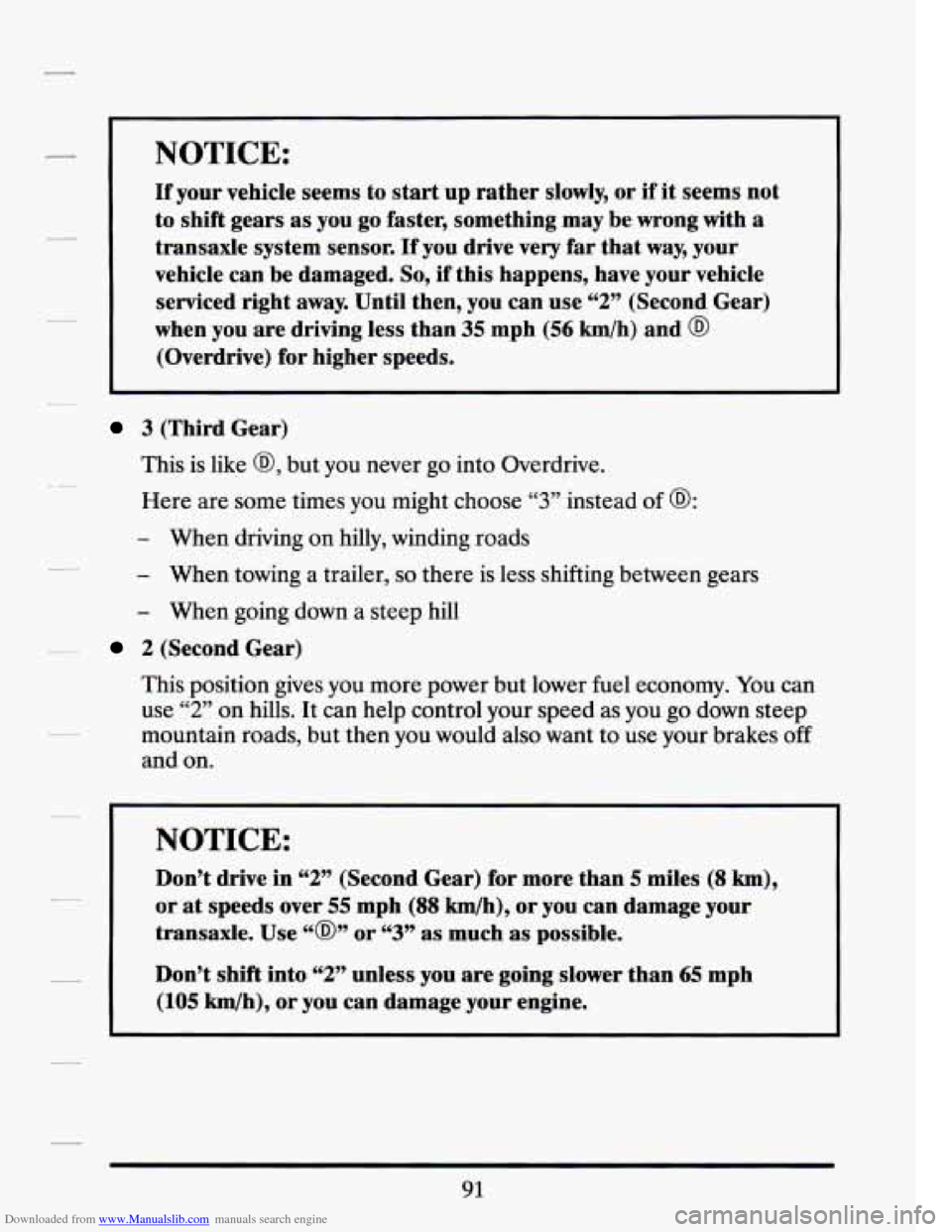
Downloaded from www.Manualslib.com manuals search engine NOTICE:
If your vehicle seems to start up rather slowly, or if it seems not
to shift gears
as you go faster, something may be wrong with a
transaxle system sensor. If you drive very far that way, your
vehicle can be damaged.
So, if this happens, have your vehicle
serviced right
away. Until then, you can use “2” (Second Gear)
when you
are driving less than 35 mph (56 km/h) and @
(Overdrive) for higher speeds.
3 (Third Gear)
This is like
@, but you never go into Overdrive.
Here are some times
you might choose “3” instead of 0:
- When driving on hilly, winding roads
- When towing a trailer, so there is less shifting between gears
- When going down a steep hill
2 (Second Gear)
This position gives
you more power but lower fuel economy. You can
use
“2” on hills. It can help control your speed as you go down steep
mountain roads, but then you would also want to use your brakes
off
and on.
NOTICE:
Don’t drive in “2” (Second Gear) for more than 5 miles (8 km),
or at speeds over 55 mph (88 km/h), or you can damage your
transaxle. Use
“@” or “3” as much as possible.
Don’t shift into
“2” unless you are going slower than 65 mph
(105 km/h), or you can damage your engine.
I
91
Page 130 of 399
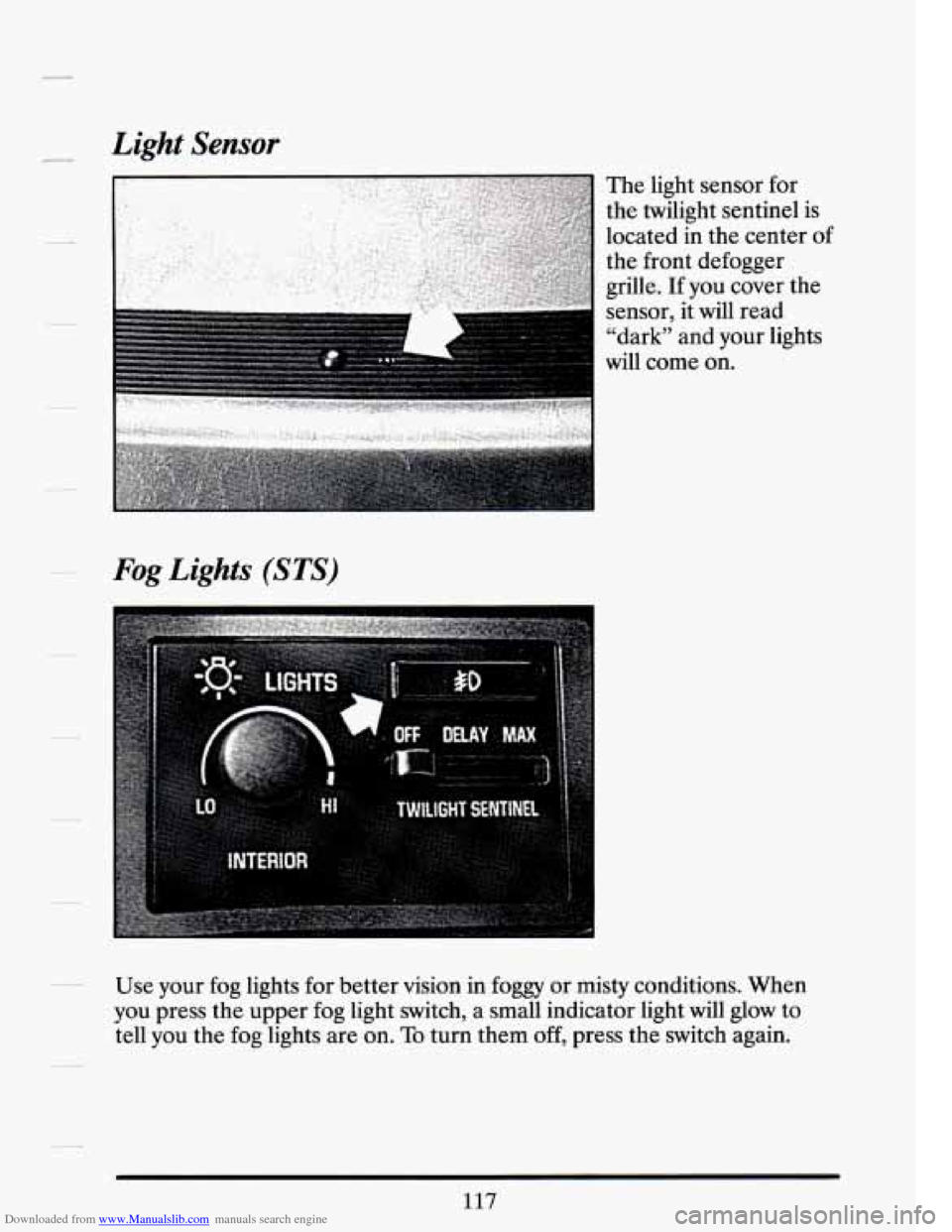
Downloaded from www.Manualslib.com manuals search engine Light Sensor
Fog Lights (STS)
Use your fog lights for better vision in foggy or misty conditions. When
you press the upper fog light switch, a small indicator light will glow to
tell you the fog lights are
on. To turn them off, press the switch again.
117
Page 131 of 399
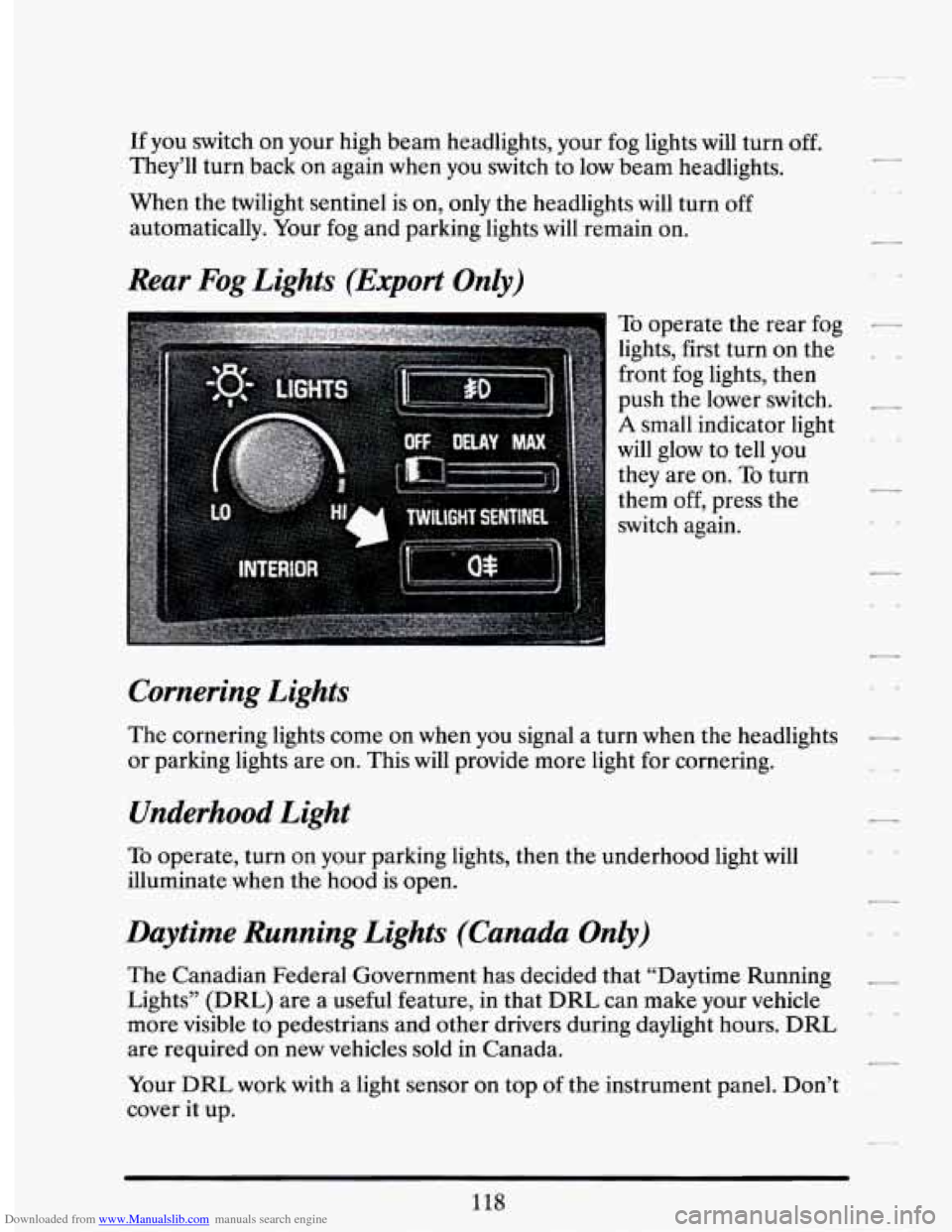
Downloaded from www.Manualslib.com manuals search engine If you switch on your high beam headlights, your fog lights will \
turn off.
They’ll turn back on again when you switch to low beam headlights.
When the twilight sentinel is on, only the headlights will turn
off
automatically. Your fog and parking lights will remain on.
Rear Fog Lights (E~port Only)
To operate the rear fog
lights, first turn on the
front fog lights, then
push the lower switch.
A small indicator light
will glow to tell you
they are on.
To turn
them
off, press the
switch again.
Cornering Lights
The cornering lights come on when you signal a turn when the headlights
or parking lights are on. This will provide more light for cornering.
Underhood Light
To operate, turn on your parking lights, then the underhood light will
illuminate when the hood is open.
Daytime Running Lights (Canada Only)
The Canadian Federal Government has decided that “Daytime Running
Lights” (DRL) are a useful feature, in that DRL can make your vehicle
more visible
to pedestrians and other drivers during daylight hours. DRL
are required on new vehicles sold in Canada.
Your DRL work with a light sensor on top
of the instrument panel. Don’t
cover it up.
Page 160 of 399
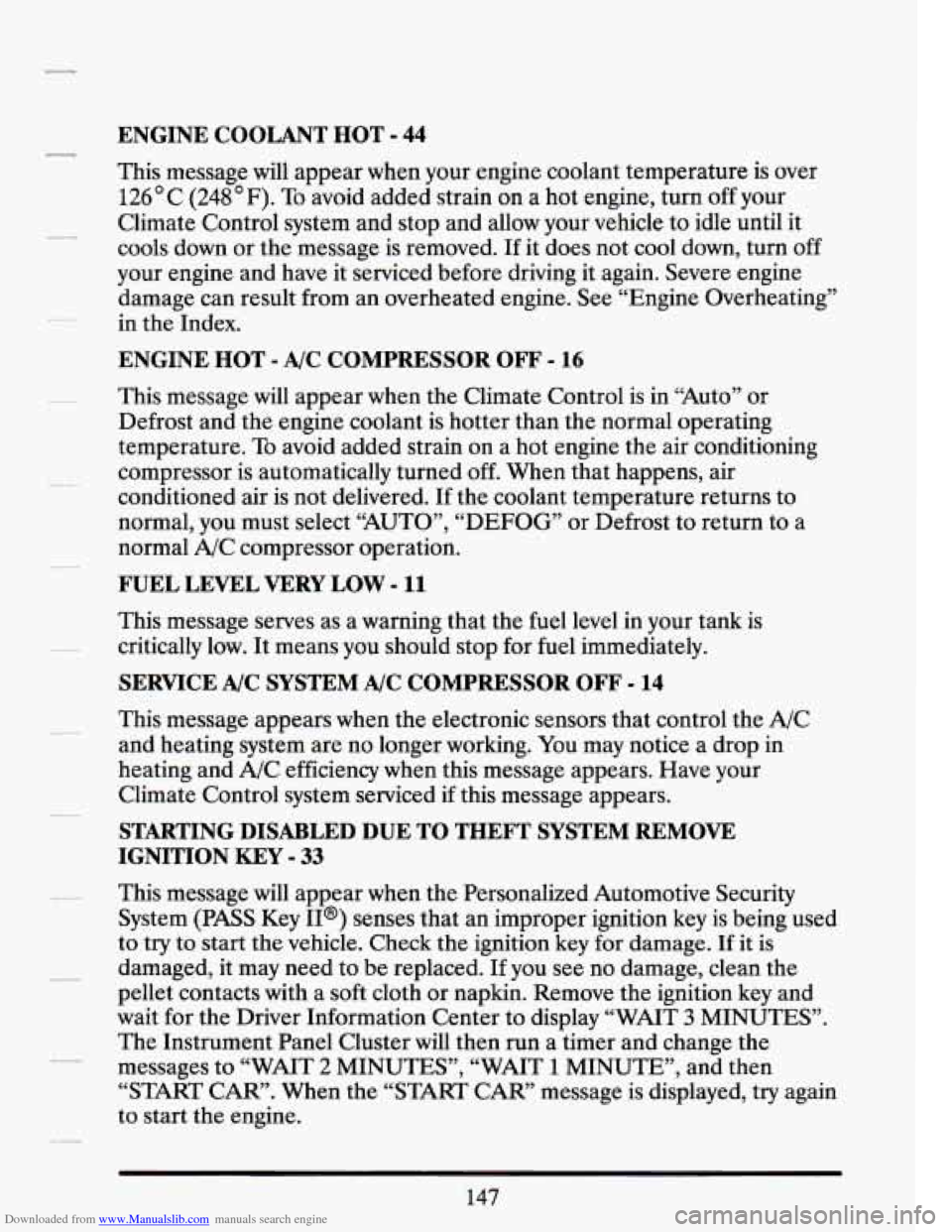
Downloaded from www.Manualslib.com manuals search engine ENGINE COOLANT HOT - 44
This message will appear when your engine coolant temperature is over
126 C (248 F). To avoid added strain on a hot engine, turn off your
Climate Control system and stop and allow your vehicle to idle until it
cools down or the message is removed.
If it does not cool down, turn off
your engine and have it serviced before driving it again. Severe engine
damage can result from an overheated engine. See “Engine Overheating”
in the Index.
ENGINE HOT - A/C COMPRESSOR OFF - 16
This message will appear when the Climate Control is in “Auto” or
Defrost and the engine coolant is hotter than the normal operating
temperature.
To avoid added strain on a hot engine the air conditioning
compressor is automatically turned
off. When that happens, air
conditioned air is not delivered.
If the coolant temperature returns to
normal, you must select “AUTO”,
“DEFOG” or Defrost to return to a
normal A/C compressor operation.
FUEL LEVEL VERY LOW - 11
This message serves as a warning that the fuel level in your tank is
critically low.
It means you should stop for fuel immediately.
SERVICE A/C SYSTEM A/C COMPRESSOR OFF - 14
This message appears when the electronic sensors that control the A/C
and heating system are no longer working.
You may notice a drop in
heating and A/C efficiency when this message appears. Have your
Climate Control system serviced if this message appears.
STARTING DISABLED DUE TO THEFT SYSTEM REMOVE
IGNITION
KEY - 33
This message will appear when the Personalized Automotive Security
System
(PASS Key II@) senses that an improper ignition key is being used
to try to start the vehicle. Check the ignition key
for damage. If it is
damaged, it may need to be replaced. If you see no damage, clean the
pellet contacts with a soft cloth or napkin. Remove the ignition key and
wait for the Driver Information Center to display “WAIT
3 MINUTES”.
The Instrument Panel Cluster will then run a timer and change the
messages to “WAIT
2 MINUTES”, “WAIT 1 MINUTE”, and then
“START CAR”. When the “START CAR” message is displayed, try again
to start the engine.
Page 163 of 399
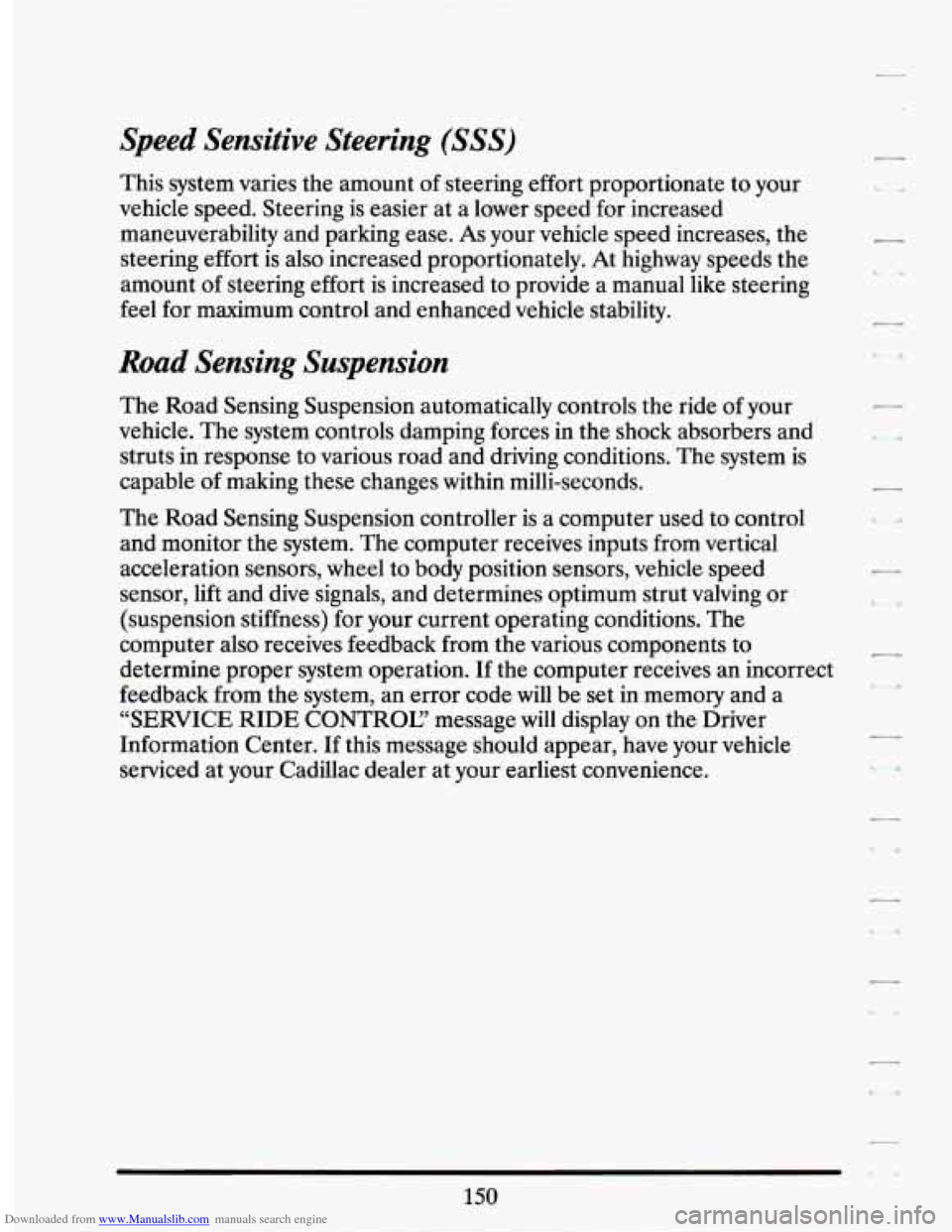
Downloaded from www.Manualslib.com manuals search engine Speed Sensitive Steering (SSS)
This system varies the amount of steering effort proportionate to your
vehicle speed. Steering is easier at a lower speed for increased
maneuverability and parking ease. As your vehicle speed increases, the
steering effort is also increased proportionately. At highway speeds the
amount
of steering effort is increased to provide a manual like steering
feel for maximum control and enhanced vehicle stability.
Road Sensing Suspension
The Road Sensing Suspension automatically controls the ride of your
vehicle. The system controls damping forces in the
shock absorbers and
struts in response to various road and driving conditions. The system is
capable
of making these changes within milli-seconds.
The Road Sensing Suspension controller is a computer used to control
and monitor the system. The computer receives inputs from vertical
acceleration sensors, wheel to body position sensors, vehicle speed
sensor, lift and dive signals, and determines optimum strut valving or
(suspension stiffness) for your current operating conditions. The
computer also receives feedback from the various components to
determine proper system operation. If the computer receives an incorrect
feedback from the system, an error code will be set in memory and a
“SERVICE
RIDE CONTROL’ message will display on the Driver
Information Center. If this message should appear, have your vehicle
serviced at your Cadillac dealer at your earliest convenience.
Page 165 of 399
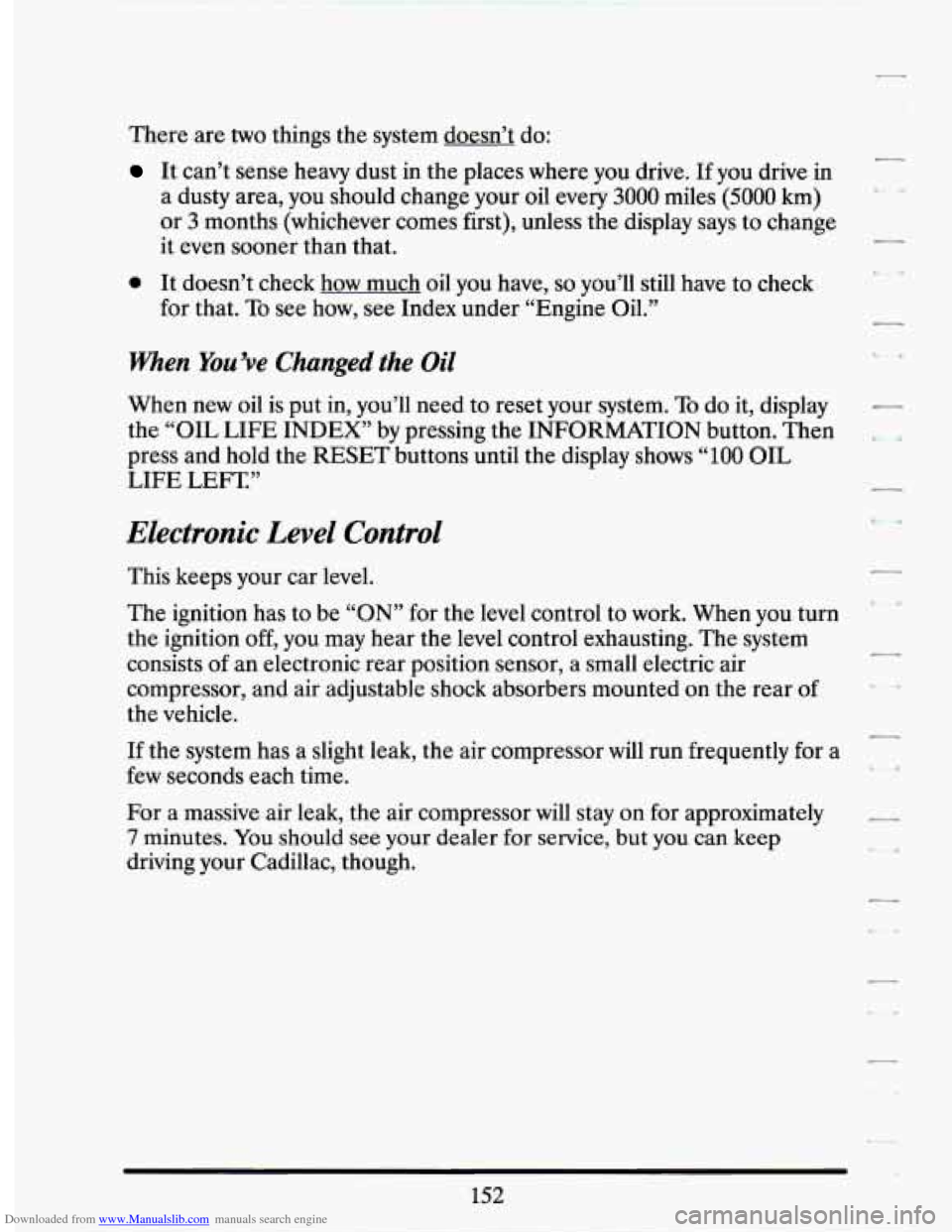
Downloaded from www.Manualslib.com manuals search engine There are two things the system doesn’t do:
It can’t sense heavy dust in the places where you drive. If you drive in
a dusty area, you should change your oil
every 3000 miles (5000 km)
or 3 months (whichever comes first), unless the display says to change
it even sooner than that.
0 It doesn’t check how much oil you have, so you’ll still have to check
for that. To see how, see Index under “Engine Oil.”
When You’ve Changed the Oil
When new oil is put in, you’ll need to reset your system. To do it, display
the “OIL
LIFE INDEX” by pressing the INFORMATION button. Then
press and hold the RESET buttons until the display shows
“100 OIL
LIFE LEFT”
Electronic Level Control
This keeps your car level.
The ignition has to be “ON” for
the level control to work. When you turn
the ignition off, you may hear the level control exhausting.
The system
consists
of an electronic rear position sensor, a small electric air
compressor, and air adjustable shock absorbers mounted on the rear
of
the vehicle.
If the system has a slight leak, the air compressor will run frequently for a
few seconds each time.
For a massive air leak, the air compressor will stay on for approximately
7 minutes. You should see your dealer for service, but you can keep
driving your Cadillac, though.
.,
Page 167 of 399
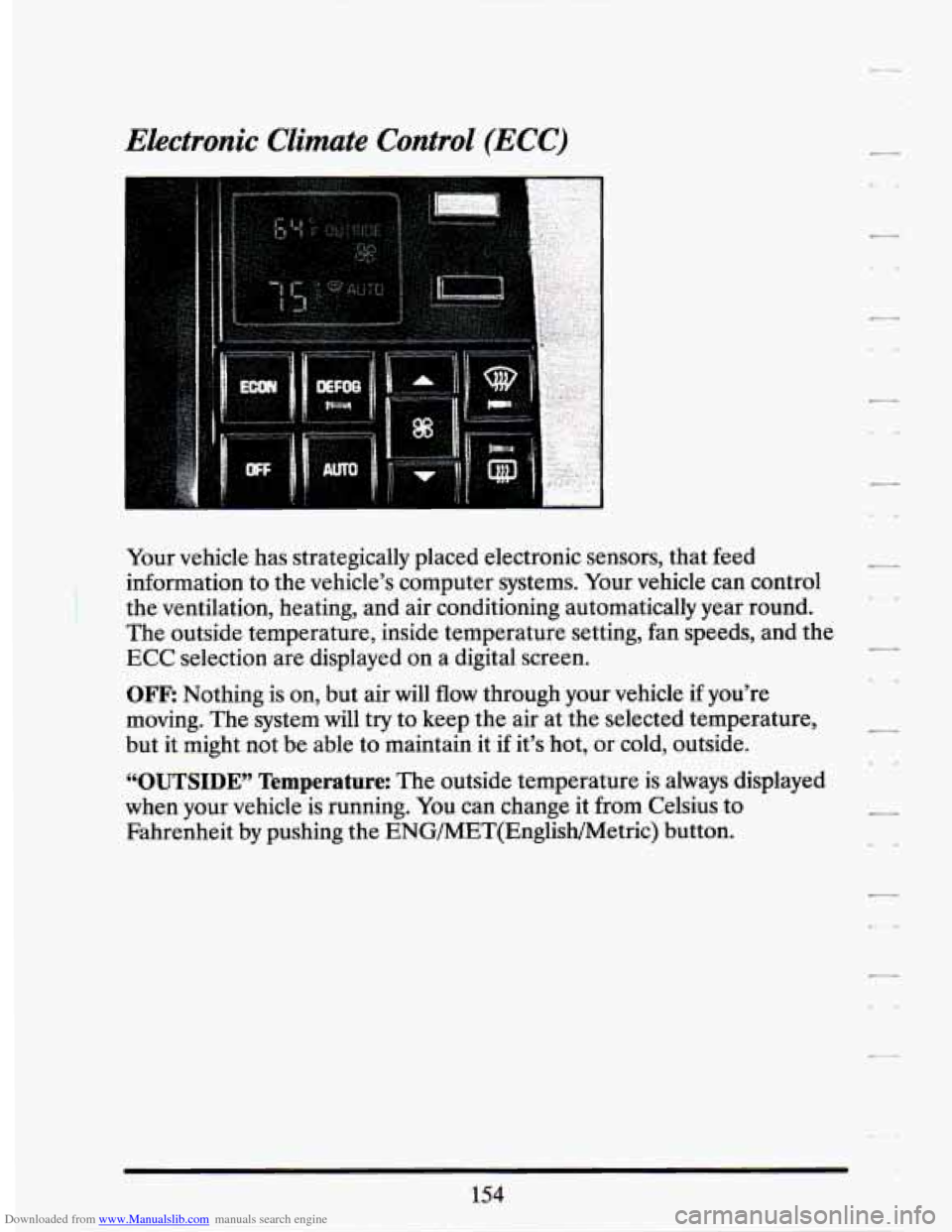
Downloaded from www.Manualslib.com manuals search engine Electronic Climate Control (ECC)
Your vehicle has strategically placed electronic sensors, that feed
information to the vehicle’s computer systems. Your vehicle can control
the ventilation, heating, and air conditioning automatically year round.
The outside temperature, inside temperature setting, fan speeds, and the
ECC selection are displayed on a digital screen.
OFF: Nothing is on, but air will flow through your vehicle if you’re
moving. The system will try to keep the air at the selected temperature,
but it might not be able to maintain it if it’s hot, or cold, outside.
“OUTSIDE” Temperature: The outside temperature is always displayed
when your vehicle is running. You can change it from Celsius to
Fahrenheit by pushing the ENG/MET(English/Metric) button.